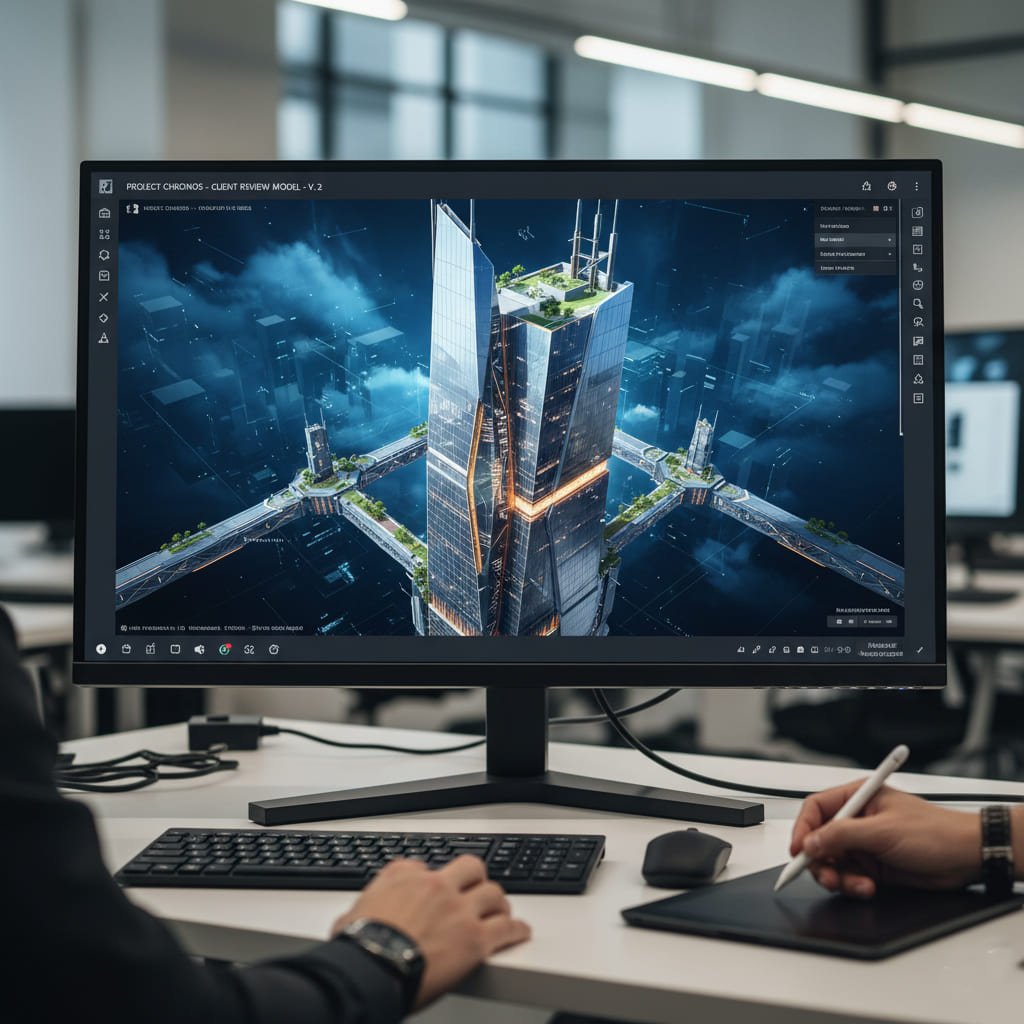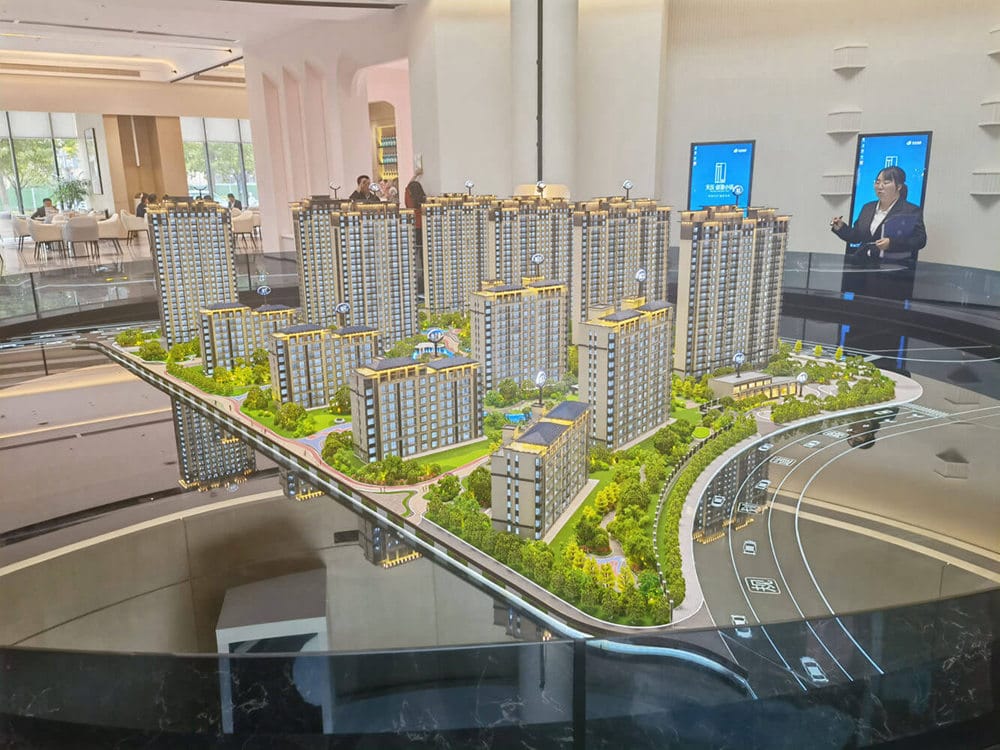¿Alguna vez has intentado explicar una hermosa, idea de diseño complejo, Solo para ser encontrado con una mirada en blanco? Ves el tono perfecto de verde salvia en las paredes, El cálido brillo de una luz colgante de latón, la textura exacta de un sillón de boucle. Pero tu cliente? Están luchando por verlo. Este es el desafío más antiguo en el diseño de interiores: Unir la vasta brecha entre la visión de un profesional y la imaginación de un cliente.
Durante décadas, Confiamos en tablas de humor, muestras de tela, y dibujos 2D planos. Ayudaron, Pero nunca realmente capturaron el alma de un espacio. No podían mostrar cómo la luz de la mañana se filtraría a través de la ventana y bailaría por el piso.. No pudieron transmitir la sensación de estar parado en la habitación terminada.
Eso ha cambiado. Hoy, Tenemos una solución revolucionaria: 3D Renderización de diseño de interiores.
Tabla de contenido
Esta poderosa tecnología se ha convertido en el estándar de oro en el mundo del diseño, Y por una buena razón. No se trata solo de crear una imagen bonita; Se trata de crear claridad, confianza, y emoción. Es un apretón de manos visual que garantiza que usted y su cliente estén soñando exactamente el mismo sueño. En esta guía final, Exploraremos todas las facetas de la representación 3D. Descubriremos:
- Los fundamentos: ¿Qué son exactamente las representaciones y cómo funcionan??
- Los beneficios: Por qué esta herramienta no es negociable para el éxito de diseño moderno.
- El proceso: Un detallado, viaje paso a paso de cómo se hace realidad un render.
- Las opciones: Explorando los diferentes tipos de representaciones y si debe bricolaje o contratar a un Pro.
- La inversión: A transparent breakdown of how much 3D rendering costs.
- The Future: A glimpse into what’s next for the world of design visualization.
Whether you’re a homeowner nervous about a big renovation, an interior designer aiming to elevate your presentations, an architect planning a new build, or a student eager to learn the tools of the trade, this guide is for you. Let’s step into the world of 3D rendering and turn imagination into reality.
Part 1: What is an Interior Design Rendering? The Core Fundamentals
Before we dive into the exciting benefits and processes, comencemos con lo básico. Understanding what a rendering is—and what it isn’t—is the first step to harnessing its power. It’s a simple concept with profound implications.
What is a 3D Interior Design Rendering?
Simplemente poner, an interior design rendering is a digital image that shows what an interior space will look like. Think of it as a photograph of the future. Using specialized computer software, a designer or 3D artist creates a virtual, three-dimensional model of a room and then generates a realistic 2D image from that model.

This isn’t just a simple sketch. A high-quality rendering, often called a 3D visualization or a photorealistic render, communicates every detail of the proposed design. Esto incluye:
- The precise layout of the room and furniture.
- The colors of the walls, ceilings, y decoracion.
- The textures and materials of flooring, fabrics, y superficies.
- Cómo la iluminación natural y artificial interactuará con el espacio.
- La escala y la proporción de cada elemento.
Es la mejor herramienta de comunicación, Tomar todos los elementos abstractos de un tablero de ánimo y plano de planta y ensamblarlos en un solo, cohesivo, e imagen visualmente impresionante.
Una breve historia: Desde bocetos dibujados a mano hasta realismo digital
Para apreciar dónde estamos hoy, Ayuda saber de dónde venimos. Por generaciones, Los diseñadores y arquitectos de interiores se basaron en métodos manuales para transmitir sus ideas. Bocetos de perspectiva dibujadas a mano, pinturas de acuarela, y los intrincados planos de planta 2D fueron las herramientas del comercio. Estos métodos tenían un encanto artístico innegable y aún son valiosos para una conceptualización rápida..
Sin embargo, Tenían sus límites. No podían replicar perfectamente el juego complejo de la luz y la sombra, Tampoco podrían ser cambiados fácilmente. Un cliente que quería ver un color sofá diferente significaba comenzar un nuevo dibujo desde cero.
Las semillas de cambio se plantaron en la década de 1960, No en diseño, Pero en industrias como la ingeniería aeroespacial y automotriz, donde se crearon los primeros modelos simples de estructura alámbrica 3D. A medida que la tecnología informática explotó a través de los años 80 y 90, Estas herramientas se volvieron más sofisticadas y encontraron su camino hacia la arquitectura.. A la década de 2000, El software se volvió potente y accesible para hacer que la representación 3D fotorrealista sea una herramienta viable para los diseñadores de interiores en todas partes. Que una vez fue un nicho, La tecnología cara es ahora el estándar de la industria, permitiendo un nivel de claridad y colaboración previamente inimaginable.
What are the Core Components of a 3D Render?
A stunning photorealistic render isn’t magic—it’s the result of four core digital components working together in perfect harmony. Understanding these building blocks helps you appreciate the artistry and technical skill involved.

Models: The Digital Skeleton
The foundation of any render is the 3D model. This is the digital architecture of the scene. Artists create the geometric shapes and structures of everything you see: las paredes, Windows, and doors that form the room, as well as every piece of furniture, every lamp, and every decorative vase. This digital “skeleton” defines the size, forma, and placement of every object in the space.
Texturas y materiales: El realista “Piel”
Un modelo 3D por sí solo es solo una colección de formas grises. Lo que lo da vida es la aplicación de materiales y texturas.. Este es el digital “piel” que le da a cada superficie su apariencia realista. Los artistas aplican mapas de textura: imágenes de alta resolución de materiales como el grano de madera, tejido de tela, venas de mármol, o acabados de metal: a los modelos. Luego se ajustan las propiedades como el ajuste como:
- Reflexión: ¿Cuánta luz se recupera una superficie?.
- Brillo: Si una superficie es brillante (como cromo pulido) o mate (como un piso de piedra).
- Golpe/desplazamiento: Pequeños detalles de la superficie que crean la ilusión de la textura, Como los surcos en la madera o los mechones de una alfombra.
Iluminación: El alma de la escena
La iluminación es posiblemente el elemento más crítico para el realismo y el estado de ánimo. Sin buena iluminación, even the best models and textures will look flat and fake. The artist sets up a complete lighting system that mimics the real world:
- Luz natural: A digital “sun and sky” system that casts realistic light and shadows through windows, changing depending on the time of day.
- Luz artificial: Placing digital versions of light fixtures like pendants, lámparas, y focos, each emitting light just as its real-world counterpart would.
This lighting interacts with all the materials in the scene, creating the bright highlights, soft shadows, and subtle reflections that make a space feel real and inviting.
Perspective and Camera: The Viewer’s Eye
Finalmente, the entire scene is viewed through a digital camera. The artist chooses the perfect camera position, angle, and focal length to create a compelling composition that best showcases the design. This determines the perspective—how objects appear in relation to one another—and ensures the final image feels balanced and professional, just like a photograph taken by a skilled architectural photographer.
3D Representación vs.. Virtual Staging: ¿Cuál es la diferencia??
This is one of the most common points of confusion in the industry. While both tools are used to visualize a property, they are fundamentally different processes with different applications. Let’s clear it up.

Virtual Staging starts with a real photograph of an existing, empty room. Un artista digital luego usa software para agregar muebles y decoración a esa foto.. Es una herramienta increíblemente útil para los agentes inmobiliarios que desean ayudar a los compradores potenciales a ver el potencial en una casa vacante. Su objetivo principal es “escenario” un espacio existente sin el costo y la molestia de los muebles físicos.
Representación 3D interior, por otro lado, crea un escena completamente digital desde cero. No hay fotografía inicial. Toda la habitación: las paredes, el piso, la iluminación, los muebles: está construido en un entorno 3D. Esto lo convierte en la herramienta perfecta para proyectos que aún no existen., como un nuevo edificio, una renovación importante, o un concepto de diseño completamente nuevo.
“Piense en ello de esta manera: La puesta en escena virtual es como decorar digitalmente una habitación real. 3D rendering is like building and decorating a digital room from the ground up.”
Here’s a simple table to highlight the key differences:
| Característica | Virtual Staging | Representación 3D interior |
|---|---|---|
| Starting Point | A real photograph of an empty room | A digital 3D model created from plans |
| Creative Flexibility | Limited. You can’t change the room’s architecture or the camera angle of the original photo. | Unlimited. You have complete control over every element, including layout, materiales, and camera views. |
| Primary Use Case | Marketing existing, vacant properties for sale or rent. | Visualizing new construction, renovations, and conceptual interior designs. |
| Mejor para | Real estate agents and property managers. | Interior designers, arquitectos, and property developers. |
Both are valuable, but they serve different needs. Knowing the difference helps you choose the right tool for your specific project.
Part 2: Why You Need Them: 10 Beneficios que cambian el juego de la representación 3D
Ahora que sabemos cuáles son las representaciones, Exploremos por qué se han vuelto tan indispensables. Los beneficios van mucho más allá de una imagen bonita; Impactan su presupuesto, Tu línea de tiempo, tus relaciones con los clientes, Y tu éxito general.
1. Ahorra tiempo y dinero: El retorno de la inversión tangible
Este es el beneficio más práctico y convincente. Hacer cambios durante la fase de diseño es fácil y económico. Haciendo cambios durante la construcción? Esa es una pesadilla de retrasos y excesos de presupuesto. Un render 3D le permite detectar fallas de diseño potenciales antes de que se marque una sola uña.
Imagine que el render revela que una isla de cocina planificada es demasiado grande, restringir el flujo de trabajo. O que la colocación de un sofá bloquea una puerta cuando se abre. Identificar estos problemas no cuesta digitalmente nada. Fixing them after they’re built could cost thousands. Además, clear visuals lead to faster decisions and approvals from clients, which shortens the overall project timeline and saves money on labor.
2. Improves Communication and Builds Unbreakable Client Trust
Interior design is filled with technical jargon and abstract concepts. Terms like “spatial flow,” “negative space,” and even specific material names can be confusing for clients. A 3D render cuts through the noise. Es un universal visual language that everyone can understand instantly. There’s no room for misinterpretation.
When a client sees a photorealistic image that perfectly matches the vision they had in their head, it builds an incredible amount of trust. They feel heard and understood. This collaborative clarity is the foundation of a great designer-client relationship and a successful project.
3. Enhances Design Decision-Making and Drastically Reduces Revisions
One of the biggest sources of client anxiety is uncertainty. “Will I like that color on all four walls?” “Is that sofa too modern for the room?” A 3D render eliminates this guesswork. It offers a “try before you buy” experience for design choices.
Want to compare a dark, moody color palette with a light, airy one? An artist can create two versions. Can’t decide between a marble or a quartz countertop? You can see both in context. This ability to experiment visually empowers clients to make confident decisions, which means fewer second-guesses and costly revisions down the line.
4. Creates a Powerful Marketing, Branding, and Sales Tool
For professionals, 3D Las representaciones son una mina de oro de marketing.
- Para diseñadores de interiores: Puede construir una cartera impresionante de su mejor trabajo, incluyendo proyectos que aún no se han construido. Esto le permite mostrar sus habilidades y su estilo único para atraer nuevos clientes..
- Para desarrolladores inmobiliarios: Puede comenzar a comercializar y vender propiedades “fuera de plan” Mucho antes de que termine la construcción. Estas imágenes crean compradores de zumbido y seguros al principio del proceso..
- Para compañías de muebles: Los productos se pueden exhibir en perfectamente curado, habitaciones digitales aspiracionales sin el gasto de construir conjuntos físicos y organizar sesiones de fotos.
Estas imágenes de alta calidad son perfectas para sitios web, redes sociales, folletos, y presentaciones, Darle a su marca un aspecto pulido y profesional.
5. Da una fuerte ventaja competitiva en un mercado lleno de gente
In today’s competitive landscape, showing up to a client pitch with 2D floor plans and a mood board is no longer enough. A competitor who presents a stunning, photorealistic 3D render of the client’s future space immediately demonstrates a higher level of professionalism, expertise, y dedicación. Offering 3D visualization sets you apart. It shows you are invested in modern tools and, más importante, in ensuring your client has total clarity and confidence in their project.
6. Provides Detailed and Accurate Visualization
A render doesn’t just show the general idea; it shows the intricate details. You can see the precise pattern of the tile, the texture of the wallpaper, the subtle veining in the wood. This level of detail ensures that every nuance of the design is seen and appreciated, No dejando nada a la imaginación.
7. Fomenta una conexión emocional profunda
Un gran diseño no se trata solo de cómo se ve un espacio; se trata de cómo se siente. Un render de alta calidad, con su iluminación realista y detalles cuidadosamente elegidos, puede evocar una poderosa respuesta emocional. Cuando un cliente ve un cálido, Invitando la imagen de su futura sala de estar, No solo ven un diseño, sino que se ven viviendo allí, Hacer recuerdos. Esta conexión emocional es invaluable para obtener un proyecto aprobado.
8. Permite una estimación de costos más precisa
Cuando cada elemento de un diseño se modela y visualiza, desde las lámparas específicas hasta el número exacto de tirones del gabinete, se vuelve mucho más fácil crear un presupuesto preciso. Este inventario visual detallado ayuda a prevenir costos inesperados y garantiza que el proyecto permanezca en el camino financieramente.
9. Colaboración del equipo de línea de línea
Un render 3D sirve como una sola fuente de verdad para todo el equipo del proyecto. El diseñador de interiores, el arquitecto, el constructor, y los diversos subcontratistas pueden referirse al mismo conjunto de imágenes. Esto asegura que todos estén alineados en el gol final, Minimizar errores y falta de comunicación entre diferentes operaciones.
10. Aumenta la participación y satisfacción del cliente
El proceso de representación es inherentemente colaborativo. Los clientes pueden ver que su espacio tome forma y proporcione comentarios en el camino. Esta participación los hace sentir como socios activos en el viaje de diseño., no solo destinatarios pasivos. Este compromiso lleva a un producto final que realmente refleja su visión., resultando en una mayor satisfacción y una mayor probabilidad de referencias.
Part 3: El espectro de la visualización: Tipos clave de representaciones interiores
No todas las representaciones se crean iguales. El tipo que elija depende de la etapa de su proyecto, Tus objetivos, y tu presupuesto. Explore el espectro de opciones, Desde bocetos simples hasta mundos virtuales totalmente inmersivos.
El estándar de la industria: 3D Presentaciones de imágenes Still
Esta es la forma más común y versátil de representación 3D. Es un solo, Imagen estática de alta resolución, como una fotografía digital, del espacio propuesto. Dentro de esta categoría, Hay dos estilos principales:

Representaciones conceptuales
A menudo hecho en un “arcilla” o estilo monocromático, Estos renders se centran en el panorama general: forma, disposición, escala, and the overall volume of the space. They deliberately leave out detailed colors and textures to allow for discussions about the core architectural and spatial elements. They are perfect for the early stages of a project.
Representaciones fotorrealistas
This is the ultimate goal for most projects. The aim is to create an image that is indistinguishable from a real photograph. Every detail—from the subtle reflections in the window to the soft wrinkles on a linen cushion—is meticulously crafted. These are used for final client presentations, materiales de marketing, and securing project approval.
Experiencias inmersivas: 360° Panoramas and Virtual Tours
A step up from a still image, a 360° panorama allows the viewer to “stand” in a fixed spot within the virtual room and look around in any direction—up, abajo, y por todas partes. Vinculando varios de estos puntos panorámicos juntos, Puedes crear un recorrido virtual simple.

“Un panorama de 360 ° ya no le muestra a su cliente una foto de la habitación; Les dejas pararse dentro de él.”
Este formato es fantástico para ayudar a los clientes a tener un verdadero sentido del espacio y sus proporciones.. Es especialmente efectivo para clientes remotos que no pueden visitar un sitio en persona.
Narración dinámica: Tutoros animados y flythroughs
Si una imagen fija es una fotografía, Un tutorial animado es una película. Este es un video pre-renderizado que guía al espectador en un viaje cinematográfico a través del espacio diseñado. La cámara puede suavemente “caminar” De habitación a habitación, Pan a través de hermosos detalles, y “volar” sobre el diseño para mostrar las conexiones entre espacios. Estos son ideales para proyectos a gran escala como hoteles, restaurantes, o casas de lujo, donde comprender el flujo y la experiencia de moverse a través del espacio es crítico.
La vanguardia: Realidad virtual (VR) y realidad aumentada (Arkansas)
Aquí es donde la visualización del diseño se vuelve verdaderamente interactiva.
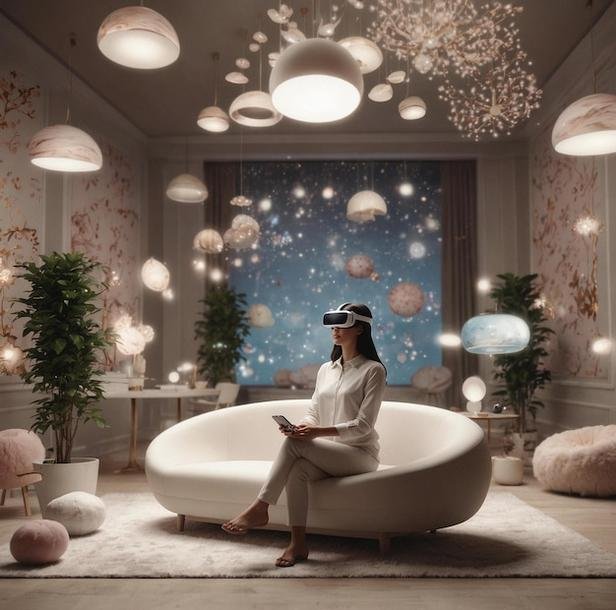
Realidad virtual (VR) Representación
Esta es la experiencia más inmersiva posible. El cliente se pone un auricular VR y se transporta digitalmente al modelo 3D. Ellos pueden “caminar” alrededor del espacio libremente, en un 1:1 escala, Como si realmente estuvieran allí. Pueden ver los detalles de cerca, Obtenga una verdadera sensación de alturas de techo, y experimentar el espacio de una manera profundamente personal. It’s a powerful tool that is revolutionizing high-end client presentations.
Realidad aumentada (Arkansas) Representación
AR doesn’t create a fully virtual world; en cambio, it overlays digital elements onto the real world, viewed through a smartphone or tablet. For interior design, this means a client can use their phone’s camera to look at their actual, existing living room and digitally place a 3D model of a new sofa in the space to see how it fits. It’s a practical and accessible way to test out new furniture and decor in a real-world context.
| Tipo de renderizado | Descripción | Mejor caso de uso |
|---|---|---|
| 3D Still Image | A single, fotorrealista “digital photograph.” | Final presentations, marketing, portfolio, client approvals. |
| 360° Panorama | An interactive image allowing the viewer to look around from a fixed point. | Giving clients a better sense of space, remote presentations. |
| Animation/Walkthrough | A cinematic video tour through the space. | Large-scale projects (hoteles, casas de lujo) to show flow and experience. |
| Realidad virtual (VR) | Una inmersión total, walkable experience using a headset. | High-end client presentations, design validation at a 1:1 escala. |
Part 4: The Professional Workflow: How a 3D Render is Created, Step-by-Step
Creating a breathtaking 3D render is a meticulous process that blends technical skill with artistic vision. While the specifics can vary, most professional studios follow a structured, multi-stage workflow to ensure efficiency and quality. Let’s walk through the journey from initial idea to final image.
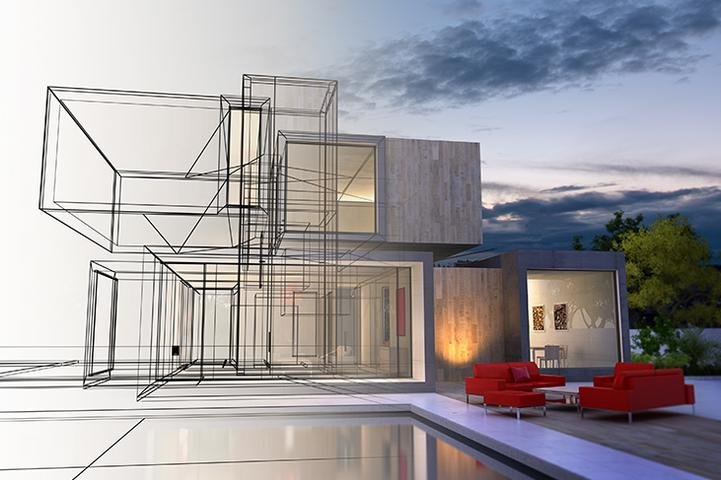
Paso 1: The Briefing & Recopilación de información
This is the most critical stage. The quality of the final render depends entirely on the quality of the initial information. A designer provides the 3D artist or studio with a comprehensive project brief, which typically includes:
- Architectural Plans: 2planos de planta D, elevaciones, and ceiling plans with precise measurements are the absolute minimum. If a 3D model already exists, that’s even better.
- Mood Boards & References: A collection of images that define the desired style, atmosphere, and color palette.
- FF&E Schedule: A list of specific Furniture, Fixtures, and Equipment.
- Camera Angle Suggestions: The designer will often suggest the key views they want to see.
The more detailed the brief, the smoother the process will be.
Paso 2: 3D Modelado – Building the Digital Architecture
Con el escrito en la mano, the 3D artist begins constructing the digital scene. They start by using the 2D plans to “extrude” las paredes, creating the basic shell of the room. They then model all the fixed architectural elements, such as cabinetry and fireplaces, and then model or import all the furniture and decorative items.
Paso 3: Configuración de la cámara – Defining the View
Early in the process, the artist will set up the proposed camera angles and send simple “arcilla” views to the designer for approval. This crucial step ensures that the final render will be framed perfectly to capture the essence of the design.
Paso 4: Textura & Materiales – Applying the Realistic Surfaces
This is where the scene starts to come to life. The artist meticulously applies the specified digital materials to every surface in the 3D model, fine-tuning properties to mimic how they would behave in the real world.
Paso 5: Iluminación – Creating the Mood and Atmosphere
The artist sets up a sophisticated lighting system, using a digital sun and sky for natural daylight and placing digital versions of lamps and pendants for artificial light. This creates the mood and realism of the scene.
Paso 6: Añadiendo “Séquito” – Bringing the Scene to Life
The magic of a believable render often lies in the “séquito”—the small, carefully placed details that suggest human presence, like a draped throw blanket or a stack of books. These elements make the space feel lived-in.
Paso 7: El proceso de renderizado – From 3D Model to 2D Image
This is a purely computational process where the computer calculates the interactions of light with every surface to generate the final image. This can take anywhere from a few minutes to many hours.
Paso 8: Postproducción & Revisiones – El esmalte final
El “raw” render is taken into a photo-editing program for final tweaks like color correction and contrast adjustment. After a client review and any minor revisions, the full-resolution, polished image is delivered.
Part 5: The Practical Decision: Bricolaje versus bricolaje. Outsourcing Your 3D Renders
Entonces, you’re sold on the power of 3D rendering. The next big question is: should you learn to do it yourself, or should you hire a professional? Both paths have their merits, and the right choice depends on your time, presupuesto, and long-term goals.
The DIY Route: Should You Create Your Own Renderings?
For the creatively curious and technically inclined, learning to create your own renderings can be an incredibly rewarding skill. Sin embargo, it’s essential to understand the commitment involved.
The Required Software
You’ll need a combination of 3D modeling software and a rendering engine. Here are some of the most popular choices:
| Software Type | Popular Programs | Mejor para |
|---|---|---|
| 3D Modelado | Bosquejo, Autodesk 3ds max, Licuadora, Cinema 4D | Building the core 3D model of the space and furniture. SketchUp is great for beginners, while Blender is a powerful free option. |
| Rendering Engine | Rayos, Renderizador de corona, Lumión, Abatimiento | Plugging into your modeling software to add realistic materials, iluminación, and generate the final image. |
Be aware that professional software can come with significant subscription costs, often thousands of dollars per year.
The Hardware Investment
3D rendering is one of the most demanding tasks you can ask of a computer. You will need a powerful desktop computer with a high-end graphics card (GPU) and a large amount of RAM to handle complex scenes. This can be an investment of several thousand dollars.
The Time and Skill Commitment
“Rome wasn’t built in a day, and neither is the skill of photorealistic rendering. It’s a craft that takes hundreds of hours to learn and thousands of hours to master.”
This is the most significant factor. Achieving a truly photorealistic result is a steep learning curve. For a busy design professional, the time spent learning software is often time taken away from core design work and client management.
The Verdict: The DIY path is best suited for students or designers who want to make 3D visualization a central part of their professional skill set. For most working designers, outsourcing is more efficient.
The Outsourcing Route: How to Choose a 3D Rendering Partner
The vast majority of interior designers choose to outsource their rendering needs to specialized studios or freelance artists. This allows them to access world-class results without the overhead. But how do you find the right partner?

Here is a checklist to guide your selection:
- ✅ Review Their Portfolio: Does the quality of their work meet your standards? Does their artistic style align with your design aesthetic?
- ✅ Look for Interior Design Specialization: A studio experienced in interiors will have a better understanding of scale, decoración, e iluminacion.
- ✅ Evaluate Their Workflow and Communication: A professional studio should have a clear process and a dedicated project manager.
- ✅ Check Turnaround Times: Ensure their delivery schedule aligns with your project deadlines.
- ✅ Confirm Guarantees and Security: Ensure the studio is willing to sign a Non-Disclosure Agreement (Acuerdo de confidencialidad) to protect your work.
Taking the time to vet your options and find the right partner will pay dividends in the quality of your visuals and the smoothness of your project.
Part 6: La inversión: How Much Do 3D Interior Rendering Services Cost?
This is often the first question on everyone’s mind. The cost of a 3D render can vary dramatically based on a number of factors. Understanding these factors will help you budget effectively.
What is the Average Cost for an Interior Rendering?
While prices are always project-specific, we can provide some general price ranges for a single still image to give you a ballpark idea.
| Rendering Quality Tier | Estimated Cost per Image (Dólar estadounidense) | Descripción |
|---|---|---|
| Básico / Conceptual | $350 – $750 | Good for early-stage design exploration, often with simpler models and lighting. |
| Mid-Range / Profesional | $750 – $1,500 | The most common tier. Alta calidad, photorealistic results suitable for client presentations. |
| De gama alta / Hyper-Realistic | $1,500 – $5,000+ | Calidad de primer nivel, often indistinguishable from a photograph. Used for luxury projects and high-end advertising. |
Animations and VR experiences are priced on a per-project basis and typically start in the low thousands.
What are the Key Factors That Influence Rendering Prices?
Entonces, what makes one render cost $500 and another $5,000? It comes down to the amount of work and expertise required. Here are the main drivers of cost:
1. Complexity of the Design and Geometry
un sencillo, minimalist living room is cheaper to model than a grand dining room with intricate crown molding and ornate furniture.
2. Level of Detail and Photorealism
Achieving that last 10% of realism takes a disproportionate amount of time and skill, which increases the cost.
3. Image Resolution
A standard web-resolution image is less expensive than an ultra-high-resolution image needed for a large-format print.
4. Number of Views and Revisions
Ordering multiple views of the same room often comes with a discount. Additional rounds of revisions beyond what is included will increase the cost.
5. Tiempo de respuesta
A rush job that requires artists to work overtime will almost always come with a priority fee.
6. Quality of Provided Materials
Providing a highly detailed, well-organized brief can reduce the artist’s time and potentially lower the cost.
Part 7: Applications in Practice: Examples of Interior Renderings by Room Type
The power of 3D rendering is best understood through real-world examples. The goals of a rendering can change depending on the specific space being designed.
Living Room Renderings
As the heart of the home, the living room focuses on creating a sense of comfort, estilo, and personality, showcasing well-arranged furniture and a welcoming atmosphere.
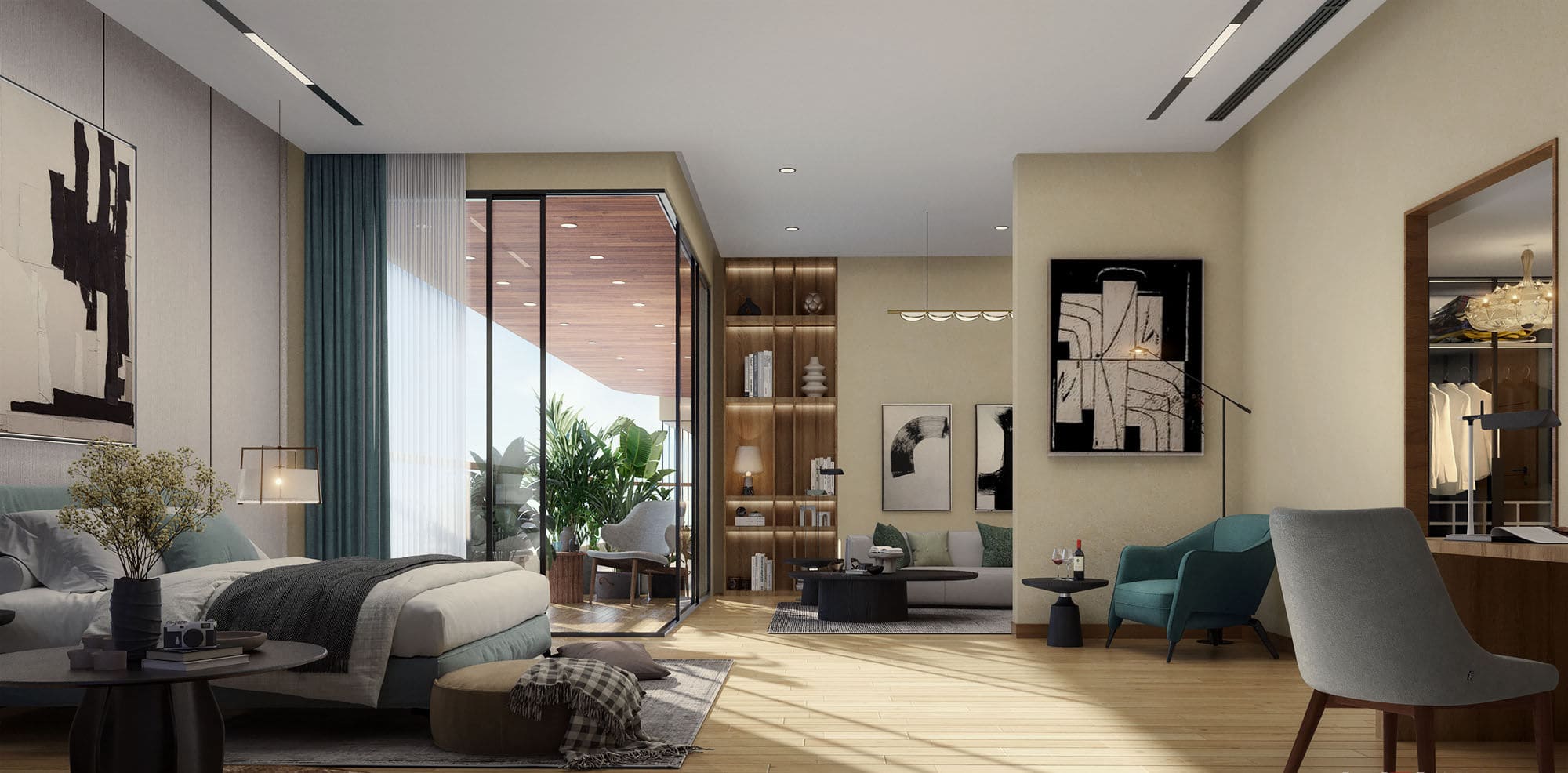
Kitchen Renderings
Kitchens are about the balance between beauty and function. A rendering is essential for visualizing layout, workflow, and material choices for cabinetry and countertops.

Bedroom Renderings
A bedroom is a personal sanctuary. These visuals showcase textiles, paletas de colores, and the soft, layered lighting that makes a bedroom feel like a cozy retreat.

Bathroom Renderings
In a smaller space, cada detalle cuenta. Bathroom renderings are perfect for highlighting intricate tile work, accesorios, and a spa-like sense of tranquility.
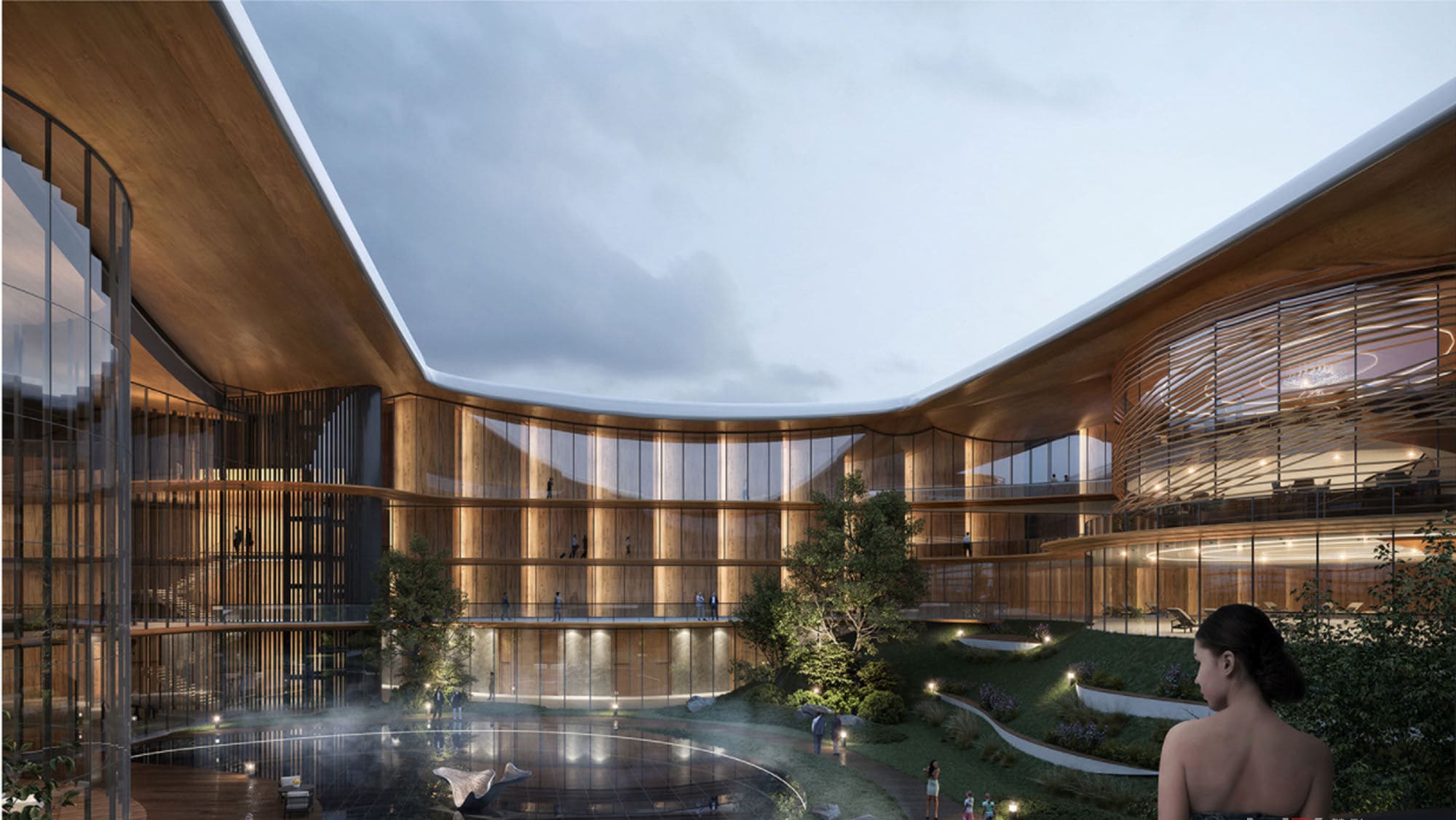
Home Office Renderings
A modern home office needs to be both inspiring and functional. Renderings for these spaces balance sophisticated aesthetics with ergonomic comfort.

Commercial Space Renderings (Restaurantes, Retail, Hoteles)
For commercial projects, the rendering visualizes the brand and the customer experience, from seating arrangements in a restaurant to product displays in a retail store.

Part 8: The Horizon: What is the Future of Interior Design Rendering?
The world of 3D visualization is not standing still. Technology is evolving at a breathtaking pace, and the tools available to designers are becoming more powerful and intelligent every year.

How Will Technology Shape the Future of Visualization?
The Role of Artificial Intelligence (AI) and Machine Learning
AI is already beginning to streamline the rendering process. AI-powered “denoising” can dramatically reduce render times. In the near future, we can expect AI to play an even bigger role, potentially suggesting design layouts or generating material palettes based on a mood board.
Real-Time Rendering and Increased Interactivity
The rise of powerful real-time rendering engines, often borrowed from the video game industry, is changing the game. These tools allow designers and clients to navigate a photorealistic 3D space in real-time. Imagine a presentation where you can change the wall color or swap out flooring and see the results instantly. This level of interactivity is the future of client collaboration.
Sustainability and Eco-Friendly Design in Visualization
As sustainability becomes more critical, rendering will be a key tool for visualizing eco-friendly choices. Designers can simulate a space’s energy efficiency or create compelling visuals that showcase the beauty of sustainable materials, helping clients make more environmentally conscious decisions.
Conclusión: Tu visión, Visualized
We’ve journeyed through the what, por qué, and how of 3D interior design rendering. We’ve seen that it is far more than just a tool for creating a pretty picture. It is a fundamental pillar of modern design practice—a catalyst for clear communication, confident decision-making, effective marketing, and ultimate project success.
The core value of 3D rendering lies in its unique ability to perfectly align the designer’s creative vision with the client’s deepest aspirations. It removes doubt, builds excitement, and ensures that the final, built space is exactly what everyone dreamed it would be.
Whether you are embarking on a simple room refresh or developing a large-scale commercial property, embracing the power of 3D visualization is the key to unlocking your design’s full potential. It’s time to stop just describing your vision and start showing it in all its stunning, photorealistic glory.
Ready to bring your own design vision to life? Explore professional 3D rendering services today and take the first step toward transforming your concepts into breathtaking reality.






